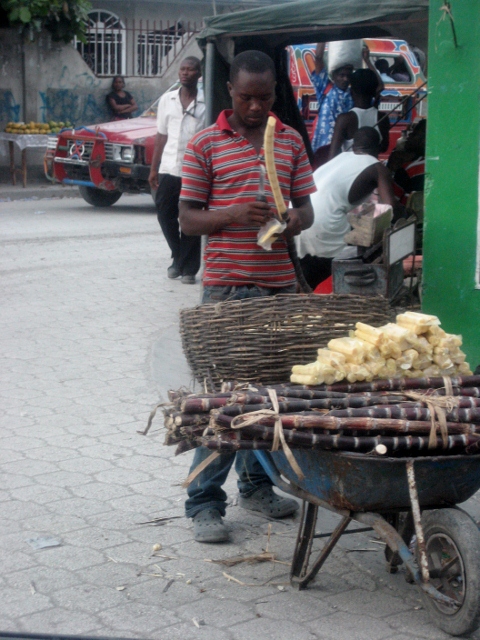Sweet Deal
Browsing through our one-of-a-kinds, I stopped and studied this sculpture of a farmer wheeling his recently harvested sugar cane to market. It reminded me of a scene I had observed and photographed along the roadway in Port-au Prince; a young man with his wheel-barrow load of cane, which he was carefully peeling for immediate purchase and consumption for passers-by.![2179[2]](https://blog.itscactus.com/wp-content/uploads/2012/10/21792.jpg)
Haiti was, at one time, a global leader in sugar production. Columbus introduced sugar cane on his second voyage to Hispanola and the under the French, production skyrocketed within their plantation system until it was rivaled only by Brazil in tonnage exported to European markets. Gradually, however, international trade policy, irrigation degradation, soil depletion, and other factors conspired to diminish the bounty. In 1976, Haiti finally failed to be even self-sufficient in terms of meeting its domestic demand for sugar, and it has never recovered.
In June 2011, Regine Barjon of BioTek Solutions/BioTek Haiti, SA reported to the United States Senate that Haiti had been reduced to producing only 2 percent of its total annual sugar needs, meaning of course, that the remaining 98 percent had to be imported. That demand alone represented 11 percent of Haiti’s total trade deficit and was contributing hugely to Haiti’s general food insecurity. Despite that, sugar remained one of Haiti’s most important cash crops, and one with great potential for jump-starting the Haitian economy. Tillable land and labor were abundant, according to Barjon. What was needed was funding for credit for farmers to irrigate, purchase seed, and fertilizer, as well as reform of global trading practices so that consumers in Haiti and beyond could afford competitively priced Haitian sugar.
Barjon was advocating for investment in Haiti’s private sector, to empower and enable small and medium businesses to exist and function in a manner that is sustainable, and thereby undercut aid dependency. Specifically, what her company was bringing to the table was a proposal to rehabilitate 15,000 hectares of existing cane fields, cleaning up watersheds, and revitalizing the one remaining sugar refinery in all of Haiti, the Darbonne Sugar Mill in Leogane. Increased production in that mill alone could potentially displace 50 percent of Haiti’s sugar imports and create 32,000 jobs. Additionally, by-products from sugar processing could be used as an energy source, with the possibility of putting out up to 20 megawatts of energy in the first 12-18 months of operation. With that, the circle could begin to close on deforestation, soil degradation, and erosion. Barjon said that the BioTek Agro-Energy Project would be financed by the International Investment Corporation (IIC), a private arm of the Inter-American Development Bank (IADB), and Haiti’s Sogebank, with potential underwriting from the Overseas Private Investment Corporation (OPIC). She had the support of the Clinton Global Initiative and was working to get the stamp of approval from the Haitian Government to move the project forward.
function in a manner that is sustainable, and thereby undercut aid dependency. Specifically, what her company was bringing to the table was a proposal to rehabilitate 15,000 hectares of existing cane fields, cleaning up watersheds, and revitalizing the one remaining sugar refinery in all of Haiti, the Darbonne Sugar Mill in Leogane. Increased production in that mill alone could potentially displace 50 percent of Haiti’s sugar imports and create 32,000 jobs. Additionally, by-products from sugar processing could be used as an energy source, with the possibility of putting out up to 20 megawatts of energy in the first 12-18 months of operation. With that, the circle could begin to close on deforestation, soil degradation, and erosion. Barjon said that the BioTek Agro-Energy Project would be financed by the International Investment Corporation (IIC), a private arm of the Inter-American Development Bank (IADB), and Haiti’s Sogebank, with potential underwriting from the Overseas Private Investment Corporation (OPIC). She had the support of the Clinton Global Initiative and was working to get the stamp of approval from the Haitian Government to move the project forward.
That Senate hearing was over a year ago. What happened then? In a phone conversation with Barjon, I got the update: Haitian President Martelly gave the go-ahead and the proposal went to the Ministry of Agriculture for final approval. It was stalled in Thomas Jacques’ ministry office ad nauseum by counter-proposals and bureaucratic red tape. On Friday, Sept 21, 2012 (Yes, less than two weeks ago!) BioTek Solutions/BioTek Haiti SA got word from the Ministry that the project got the “unofficial” green light. As for the US Senate’s response to the hearing, it is apparently held up until the Haitian government goes official on its approval. THEN, it will be in their power to release funding for credit and private sector investment, as well as adopt trade practices that will encourage indigenous agricultural development and ultimately foster food security in Haiti. It could be such a sweet deal.
